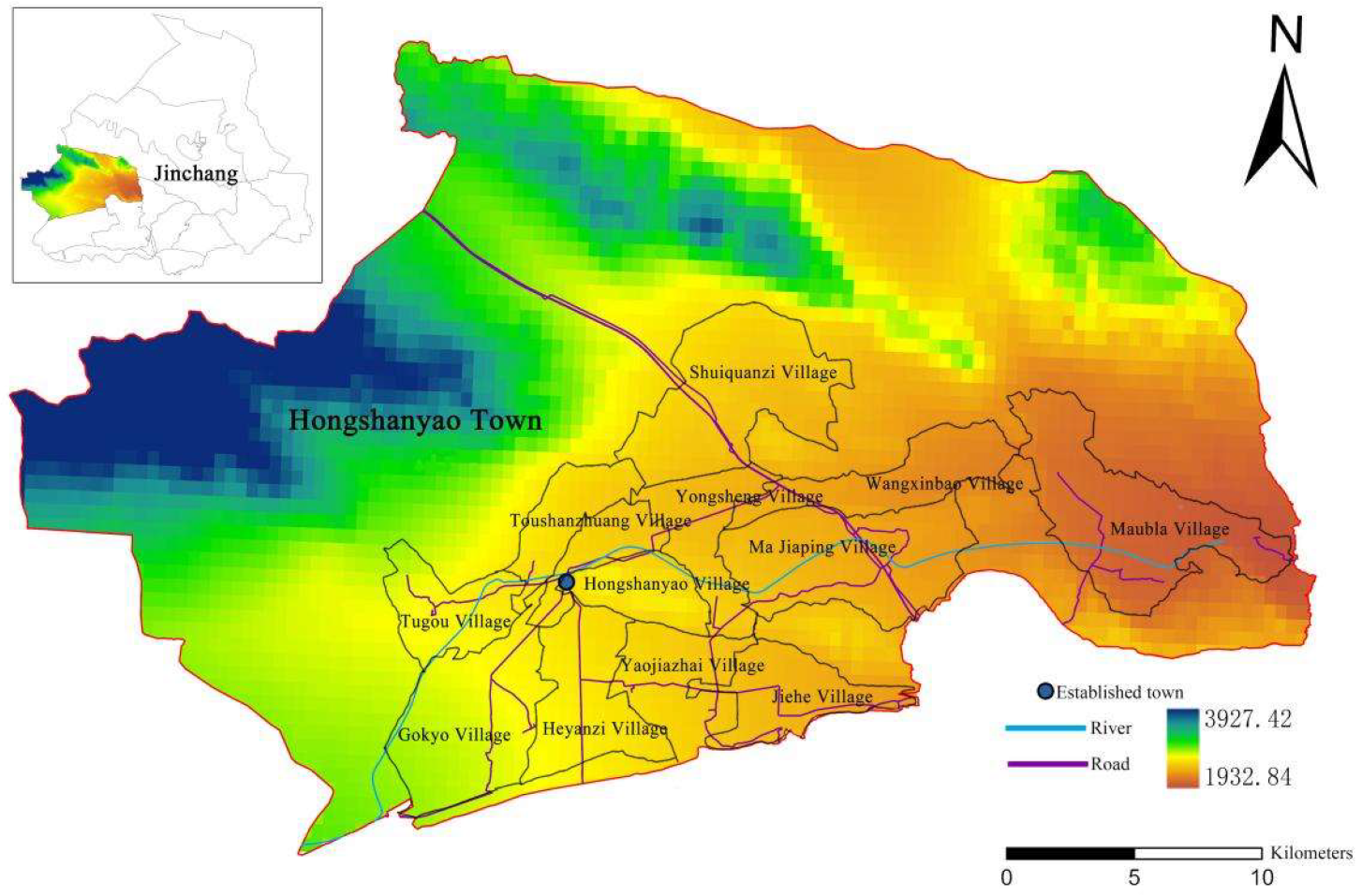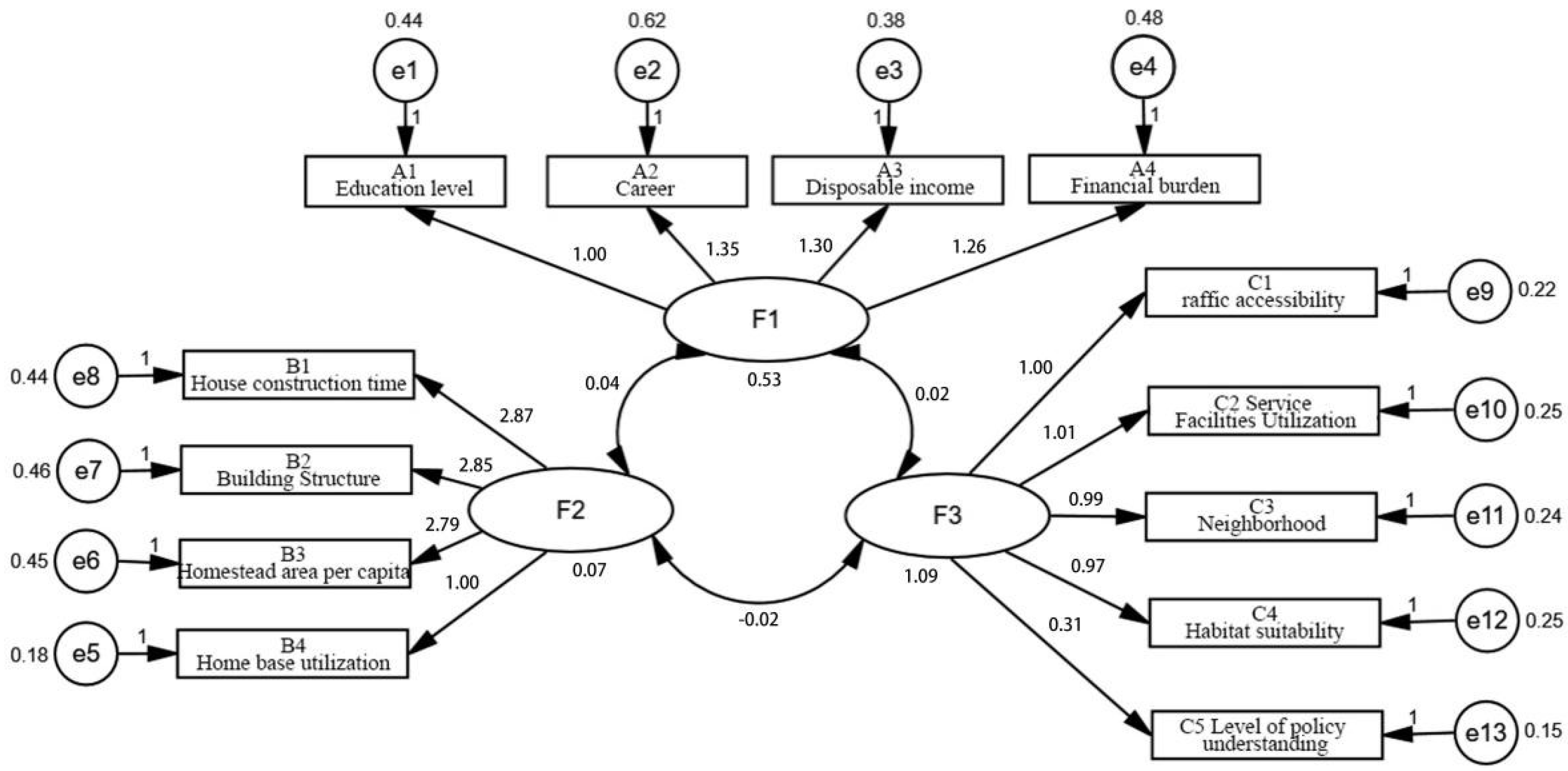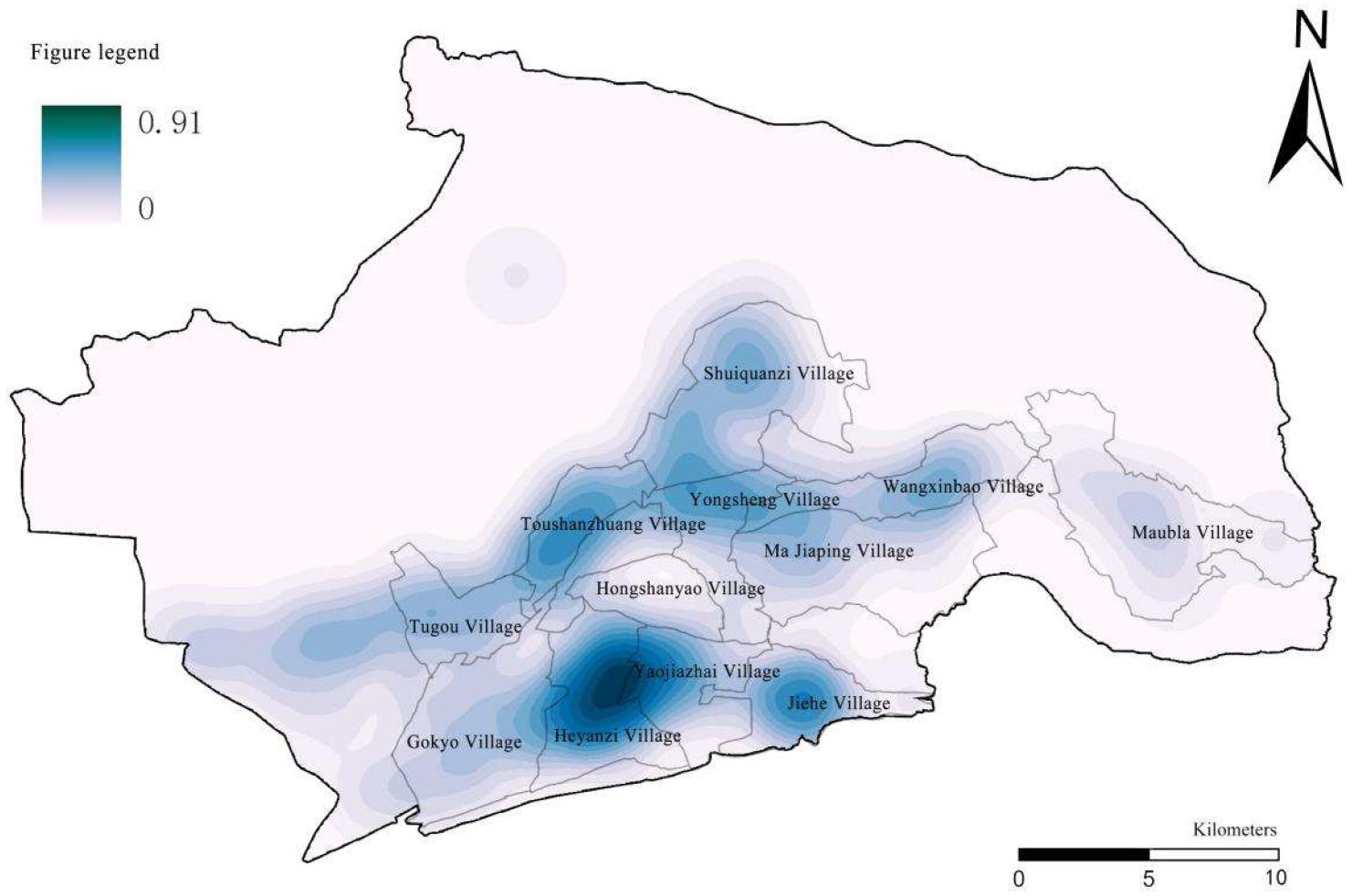Reconstructing Rural Settlements Based on Structural Equation Modeling—Taking Hongshanyao Town of Jinchang City as an Example
Abstract
1. Introduction
2. Materials and Methods
2.1. Research Area
2.2. Data Description
2.3. Research Methodology
2.3.1. Model Assumptions and SEM Model Construction
2.3.2. Variable Selection
2.3.3. Reliability and Validity Tests
2.3.4. Suitability Evaluation Index Selection
3. Results
3.1. Model Construction and Data Analysis
3.2. Rural Settlement Suitability Evaluation
4. Discussion
4.1. Rural Settlement Layout Characteristics
4.2. Rural Settlement Reconfiguration Model
5. Conclusions
Author Contributions
Funding
Institutional Review Board Statement
Informed Consent Statement
Data Availability Statement
Acknowledgments
Conflicts of Interest
References
- Chan, Z.; Bohua, L.; Cuifei, L.; Xiangyi, L.; Yindi, D. Identification of village development types and revitalization measures in less developed areas—Fenghuang County, Xiangxi Prefecture as an example. Econ. Geogr. 2021, 41, 167–176. [Google Scholar] [CrossRef]
- Qu, Y.; Wang, S.; Tian, Y.; Jiang, G.; Zhou, T.; Meng, L. Territorial spatial planning for regional high-quality development–An analytical framework for the identification, mediation and transmission of potential land utilization conflicts in the Yellow River Delta. Land Use Policy 2023, 125, 106462. [Google Scholar]
- Zhou, X.; Lu, X.; Lian, H.; Chen, Y.; Wu, Y. Construction of a Spatial Planning system at city-level: Case study of “integration of multi-planning” in Yulin City, China. Habitat Int. 2017, 65, 32–48. [Google Scholar] [CrossRef]
- Zhao, M. A study on the rural classification model based on potential assessment-taking the Anshun City of Guizhou Province as an example. Urban Archit. 2021, 18, 18–22. [Google Scholar] [CrossRef]
- Jiang, X.; Shi, Y.; Wang, Y.; Ma, Y.; Zhou, Y. Research on the classification method of villages at the scale of natural settlements—Tianwei County as an example. Small Town Constr. 2020, 38, 66–75. [Google Scholar]
- Tan, J.; Jin, Y.; Xu, Q.; Fu, G. Exploring the spatial layout planning of county urban and rural villages—Yiwu city as an example. Small Town Constr. 2022, 40, 35–43+50. [Google Scholar]
- Zhang, Z.; Liu, J.; Gu, X. Reduction of industrial land beyond Urban Development Boundary in Shanghai: Differences in policy responses and impact on towns and villages. Land Use Policy 2019, 82, 620–630. [Google Scholar] [CrossRef]
- Zhu, B.; Li, H.; Hu, Z.; Wen, Y.; Che, J. An Evaluation and Optimization of the Spatial Pattern of County Rural Settlements: A Case Study of Changshu City in the Yangtze River Delta, China. Land 2022, 11, 1412. [Google Scholar] [CrossRef]
- Xu, R.; Wang, X. GIS-based suitability evaluation and optimization strategy of rural settlements in Ganjiang River basin. Sino-Foreign Archit. 2022, 90–95. [Google Scholar] [CrossRef]
- Liu, Y.; Long, H.; Chen, Y.; Wang, J.; Yurui, L.; Li, Y.; Yang, Y.; Zhou, Y. Progress of research on urban-rural transformation and rural development in China in the past decade and future prospects. J. Geogr. Sci. 2016, 26, 1117–1132. [Google Scholar] [CrossRef]
- Kong, X.; Liu, D.; Tian, Y.; Liu, Y. Multi-objective spatial reconstruction of rural settlements considering intervillage social connections. J. Rural. Stud. 2021, 84, 254–264. [Google Scholar] [CrossRef]
- Mao, F.; Yu, Q.; Zhao, X. Research on the factors influencing the suitability of rural habitat environment based on structural equation modeling—An example of Zhang Guying village in Hunan Province. J. Hunan Univ. Technol. 2020, 34, 80–89. [Google Scholar]
- Liu, X. Research on the reconstructing mode and reconstructing path of rural villages in northern Jiangsu under the background of rural revitalization strategy. J. Jinling Inst. Sci. Technol. (Soc. Sci. Ed.) 2022, 36, 9–16. [Google Scholar] [CrossRef]
- Even, C.; Zhang, M.; Yao, M.; Luo, M.; Ren, K. Analysis of distribution characteristics and influencing factors of rural settlements in northern Anhui. J. Zunyi Norm. Coll. 2022, 24, 60–63. [Google Scholar]
- Zhao, X.; Zhang, S.; Liu, J.; Ou, Y.; Wang, X.; Zhang, L. The evolutionary trajectory and pattern reconstruction of rural “three living spaces” in a synergistic perspective. Jiangxi J. Agric. 2021, 33, 136–142. [Google Scholar] [CrossRef]
- Gao, J.; Wei, Y.D.; Chen, W.; Yenneti, K. Urban land expansion and structural change in the Yangtze River Delta, China. Sustainability 2015, 7, 10281–10307. [Google Scholar] [CrossRef]
- Lu, M.; Wei, L.; Ge, D.; Sun, D.; Zhang, Z.; Lu, Y. Spatial optimization of rural settlements based on the perspective of appropriateness–domination: A case of Xinyi City. Habitat Int. 2020, 98, 102148. [Google Scholar] [CrossRef]
- Zhou, T.; Jiang, G.; Zhang, R.; Zheng, Q.; Ma, W.; Zhao, Q.; Li, Y. Addressing the rural in situ urbanization (RISU) in the Beijing–Tianjin–Hebei region: Spatio-temporal pattern and driving mechanism. Cities 2018, 75, 59–71. [Google Scholar] [CrossRef]
- Liu, J.; Guo, C.; Liu, Y.; Hou, Y.X.; Wang, A. Spatial Reconstruction of Rural Spaces with Coupled Suitability-Intensification Coordination in Plain Agricultural Areas. J. Agric. Resour. Environ. 2022, 39, 394–405. [Google Scholar] [CrossRef]
- Ma, L.; Dou, H.; Xie, Z.; Guo, X. Research on rural settlement reconfiguration model based on integration of drivers and suitability evaluation. J. Agric. Eng. 2019, 35, 246–255. [Google Scholar]
- An, Y.; Chen, W. A study on the distribution and suitability of rural settlements based on mathematical statistics—Taking Zhuoni County of Gansu Province as an example. Gansu J. Sci. 2021, 33, 120–128. [Google Scholar] [CrossRef]
- Zhang, Y.; Zhang, Y.; Song, X. Evaluation of land suitability of rural settlements in Jinghong in the context of rural revitalization. Yunnan Geogr. Environ. Res. 2021, 33, 34–41+49. [Google Scholar]
- Rong, Y.; Cao, S.; Liu, Z. Research on village classification techniques and methods in the context of territorial spatial planning—Tianjin Jizhou District as an example. J. Beijing Univ. Archit. 2021, 37, 51–59. [Google Scholar] [CrossRef]
- Dong, T.; Meng, W. An interactive analysis of the spatial shaping of Anshun Tunbao minshuku and the reconstruction of the countryside. J. Anshun Coll. 2020, 22, 19–24. [Google Scholar]
- Tang, X.; Yu, J.; Chen, Y.; Wen, Y. Evaluation of land suitability of rural settlements in the context of rural revitalization—Cili County as an example. J. Hubei Univ. (Nat. Sci. Ed.) 2020, 42, 531–538. [Google Scholar]
- Gu, C.; Wu, F. Urbanization in China: Processes and policies. China Rev. 2010, 10, 1–9. [Google Scholar]
- Tu, S.; Long, H. A theoretical analysis of spatial reconstruction of rural settlements. Geoscience 2020, 40, 509–517. [Google Scholar] [CrossRef]
- Li, J.; Chen, G. Spatial distribution characteristics of rural settlements under the strategy of rural revitalization—Taking Ma Liu town as an example. Rural Econ. Technol. 2019, 30, 16–20. [Google Scholar]
- Yang, Y.; Deng, X.Z.; Wu, F.; Chen, T. Analysis of the evolution of rural settlements and socio-economic influencing factors in the North China Plain. Hum. Geogr. 2019, 34, 116–124. [Google Scholar] [CrossRef]
- Tian, Y.; Liu, Y.; Liu, X.; Kong, X.; Liu, G. Restructuring rural settlements based on subjective well-being (SWB): A case study in Hubei province, central China. Land Use Policy 2017, 63, 255–265. [Google Scholar] [CrossRef]
- Li, L. Analysis of the survey of rural residents’ life satisfaction based on SEM model—Shanxi Province as an example. J. Chang. Univ. 2020, 34, 68–72. [Google Scholar]
- Xi, J.; Wang, X.; Kong, Q.; Zhang, N. Spatial morphology evolution of rural settlements induced by tourism. J. Geogr. Sci. 2015, 25, 497–511. [Google Scholar] [CrossRef]
- Chang, Y.; Lei, J.; Zhang, Y.; Kong, X.; Yang, S. Analysis of rural road distribution characteristics and its influencing factors in low mountain hilly areas-an example of Siziwangqi farming area in Inner Mongolia. Arid Zone Resour. Environ. 2016, 30, 55–59. [Google Scholar] [CrossRef]
- Wang, Y.; Song, J. Study on the spatial layout optimization of rural settlements in the Qinling Mountains—Shangluo City as an example. Small Town Constr. 2021, 39, 25–33. [Google Scholar]
- Zhou, Y.; Luo, Z.; Geng, L. Cluster planning of rural settlements in mountainous areas based on “smart shrinkage”: The case of Longquan Town, Yichang City, Hubei Province. Planner 2016, 32, 86–91. [Google Scholar]
- Shan. Y.B.; Ma, X.D.; Xuan, Y. Spatial suitability analysis of rural settlements in Xuzhou based on GIS. Geogr. Res. Dev. 2012, 31, 156–160. [Google Scholar]
- Sun, H.; Zhao, X. Research on the optimization path of rural habitat system—An empirical analysis based on structural equation modeling. J. Beijing Univ. Aeronaut. Astronaut. (Soc. Sci. Ed.) 2018, 31, 70–77+97. [Google Scholar]
- Su, Z.H.; Yu, B.P.; Fan, S.; Wang, Y. Study of village type recognition in Chuzhou City based on suitability evaluation. Anhui Agron. Bull. 2022, 28, 8–13. [Google Scholar]
- Zhou, X. Spatial distribution of rural settlements in Chongqing and its optimization strategy. J. Chizhou Coll. 2011, 25, 13–16. [Google Scholar] [CrossRef]






| Village | Number of Samples | Effective Sample Size |
|---|---|---|
| Hongshanyao Village | 50 | 48 |
| Shantouzhuang Village | 50 | 45 |
| Shuiquanzi Village | 50 | 42 |
| Yongsheng Village | 50 | 46 |
| Wangxinbao Village | 50 | 41 |
| Ma Jiaping Village | 50 | 42 |
| Jiehe Village | 50 | 48 |
| Yaojiazhai Village | 50 | 43 |
| Heyanzi Village | 50 | 44 |
| Gokyo Village | 50 | 44 |
| Tugou Village | 50 | 45 |
| Maubla Village | 50 | 41 |
| Total | 600 | 0 |
| Latent Variable | Explicit Variables | Variable Definition and Description |
|---|---|---|
| Family characteristics (F1) | Education level (A1) | 1 = elementary school; 2 = middle school; 3 = high school. 4 = Secondary, college; 5 = Bachelor and above |
| Occupation (A2) | 1 = farmers; 2 = village officials; 3 = individuals. 4 = public official; 5 = other | |
| Disposable income (A3) | 1 = in short supply; 2 = subsistence; 3 = just right. 4 = Adequate; 5 = Rich | |
| Financial burden (A4) | 1 = very heavy burden; 2 = heavy burden; 3 = average burden; 4 = light burden; 5 = no burden | |
| Residence characteristics (F2) | House construction time (B1) | 1 = before 1981; 2 = between 198 and 990; 3 = between 199 and 000; 4 = between 200 and 010; 5 = between 201 and 020 |
| Building Structure (B2) | 1 = adobe; 2 = adobe structure; 3 = brick structure; 4 = brick and concrete; 5 = steel and concrete | |
| Homestead area per capita (B3) | 1 = very low; 2 = low; 3 = just right. 4 = high; 5 = very high | |
| Residential base utilization (B4) | 0 = no idle; 1 = with idle | |
| Social Characteristics (F3) | Traffic accessibility (C1) | 1 = very poorly ventilated; 2 = poorly ventilated; 3 = generally ventilated; 4 = ventilated; 5 = very ventilated |
| Service facility utilization (C2) | 1 = very dissatisfied; 2 = not satisfied; 3 = fairly satisfied; 4 = satisfied; 5 = very satisfied | |
| Neighborhood (C3) | 1 = very bad; 2 = bad; 3 = fair. 4 = good; 5 = very good | |
| Habitat suitability (C4) | 1 = very unsuitable; 2 = unsuitable; 3 = generally suitable; 4 = suitable; 5 = very suitable | |
| Level of knowledge of policies (C5) | 0 = no knowledge; 1 = knowledge |
| Indicators | Average Value | Standard Deviation | Number of Cases |
|---|---|---|---|
| A1 Literacy | 2.73 | 0.984 | 529 |
| A2 Careers | 2.59 | 1.258 | 529 |
| A3 disposable income | 2.68 | 1.130 | 529 |
| A4 Economic burden | 2.75 | 1.149 | 529 |
| B1 house construction time | 2.44 | 1.015 | 529 |
| B2 building structure | 2.42 | 1.021 | 529 |
| B3 per capita home base area | 2.41 | 1.002 | 529 |
| B4 residential base utilization | 0.50 | 0.500 | 529 |
| C1 Traffic accessibility | 2.70 | 1.148 | 529 |
| C2 service facility utilization | 2.72 | 1.171 | 529 |
| C3 Neighborhood | 2.69 | 1.151 | 529 |
| C4 Habitat Suitability | 2.64 | 1.138 | 529 |
| Level of understanding of C5 policy | 0.54 | 0.499 | 529 |
| Name | Value | |
|---|---|---|
| KMO Sampling suitability quantity | 0.845 | |
| Bartlett’s sphericity test | Approximate cardinality | 4036.250 |
| Degree of freedom | 78 | |
| Significance | 0.000 | |
| Evaluation Category | Reference Standards | Default Model | Saturation Model | Independent Models | Reference Value |
|---|---|---|---|---|---|
| Absolute Adaptation Index | Cardinality CMIN | 150.415 | 0 | 4076.136 | -- |
| Degree of Freedom DF | 62 | 0 | 78 | -- | |
| The probability of significance P | 0.072 | 0 | >0.05 | ||
| Goodness-of-fit index GFI | 0.959 | 1 | 0.407 | >0.9 | |
| Adjusted Adaptation Index AGFI | 0.94 | 0.309 | >0.9 | ||
| Difference divided by degrees of freedom CMIN/DF | 1.426 | 52.258 | <2 | ||
| Asymptotic residual mean square and square root RMSEA | 0.032 | 0.312 | <0.05 | ||
| Value Added Adaptation Index | Value-added Adaptation Index IFI | 0.978 | 1.0 | 0.0 | >0.9 |
| Non-standard adaptation index TLI | 0.972 | 0.0 | >0.9 | ||
| Comparative Fit Index CFI | 0.978 | 1.0 | 0.0 | >0.9 | |
| Simplicity Adaptation Index | Information school standard AIC | 208.415 | 182 | 4102.136 | -- |
| Minimalist Adjusted Gauge Fit Index PNFI | 0.766 | 0.0 | 0.0 | >0.5 | |
| Minimalist Adaptation Adjustment Index PCFI | 0.777 | 0.0 | 0.0 | >0 |
| Indicators | Unstandardized Estimates | Standard Error S.E. | Critical Ratio C.R. | Standardized Estimates | |
|---|---|---|---|---|---|
| F1 | A1 Literacy | 1 | 0.738 | ||
| A2 Careers | 1.349 | 0.08 | 16.889 | 0.779 | |
| A3 disposable income | 1.303 | 0.073 | 17.898 | 0.838 | |
| A4 Economic burden | 1.265 | 0.072 | 17.560 | 0.800 | |
| F2 | B1 house construction time | 2.871 | 0.261 | 11.011 | 0.756 |
| B2 building structure | 2.851 | 0.263 | 10.850 | 0.747 | |
| B3 per capita home base area | 2.786 | 0.256 | 10.887 | 0.744 | |
| B4 residential base utilization | 1s | 0.534 | |||
| F3 | C1 Traffic accessibility | 1 | 0.912 | ||
| C2 service facility utilization | 1.01 | 0.03 | 33.319 | 0.904 | |
| C3 Neighborhood | 0.993 | 0.03 | 33.455 | 0.904 | |
| C4 Habitat Suitability | 0.974 | 0.03 | 32.809 | 0.897 | |
| 54111′ | C5 Level of understanding of policy | 0.305 | 0.017 | 17.432 | 0.640 |
| Target Layer | Guideline Layer | Indicator Layer | Indicator Functions | Weights | Properties |
|---|---|---|---|---|---|
| Comprehensive impact evaluation index system of rural settlements A | Physical Geography B1 | Elevation C1 | Judging the relocation and integration areas of rural settlements based on their innate factors | 0.61 | Negative |
| Slope C2 | 0.31 | Negative | |||
| Slope direction C3 | 0.23 | Positive | |||
| Agricultural development conditions B2 | Arable land per capita C4 | Advantages and disadvantages of agricultural development as the basis for the survival of farmers | 0.42 | Positive | |
| Food production C5 | 0.38 | Positive | |||
| Kojubi C6 | 0.48 | Positive | |||
| Status of agricultural facilities C7 | 0.36 | Positive | |||
| Settlement base condition B3 | The population size of the settlement C8 | Determine the trend of settlement development based on the land and population size of rural residents | 0.23 | Positive | |
| Settlement site size C9 | 0.32 | Positive | |||
| Per capita settlement area C10 | 0.28 | Positive | |||
| Average tillage straight-line distance C11 | 0.35 | Negative | |||
| Location condition B4 | Distance from the main road C12 | Determine the construction location of the settlement with the aid of location conditions | 0.62 | Negative | |
| Distance from established towns C13 | 0.42 | Negative | |||
| Distance from village council C14 | 0.36 | Negative | |||
| Distance to river C15 | 0.56 | Negative | |||
| Comprehensive economic development conditions B5 | Net income per capita C16 | Assist in determining the construction location of the settlement | 0.53 | Positive | |
| Traffic accessibility C17 | 0.63 | Positive | |||
| Infrastructure Convenience C18 | 0.34 | Positive |
Disclaimer/Publisher’s Note: The statements, opinions and data contained in all publications are solely those of the individual author(s) and contributor(s) and not of MDPI and/or the editor(s). MDPI and/or the editor(s) disclaim responsibility for any injury to people or property resulting from any ideas, methods, instructions or products referred to in the content. |
© 2023 by the authors. Licensee MDPI, Basel, Switzerland. This article is an open access article distributed under the terms and conditions of the Creative Commons Attribution (CC BY) license (https://creativecommons.org/licenses/by/4.0/).
Share and Cite
Xie, X.; Ye, L. Reconstructing Rural Settlements Based on Structural Equation Modeling—Taking Hongshanyao Town of Jinchang City as an Example. Sustainability 2023, 15, 1338. https://doi.org/10.3390/su15021338
Xie X, Ye L. Reconstructing Rural Settlements Based on Structural Equation Modeling—Taking Hongshanyao Town of Jinchang City as an Example. Sustainability. 2023; 15(2):1338. https://doi.org/10.3390/su15021338
Chicago/Turabian StyleXie, Xiaoling, and Lin Ye. 2023. "Reconstructing Rural Settlements Based on Structural Equation Modeling—Taking Hongshanyao Town of Jinchang City as an Example" Sustainability 15, no. 2: 1338. https://doi.org/10.3390/su15021338
APA StyleXie, X., & Ye, L. (2023). Reconstructing Rural Settlements Based on Structural Equation Modeling—Taking Hongshanyao Town of Jinchang City as an Example. Sustainability, 15(2), 1338. https://doi.org/10.3390/su15021338








